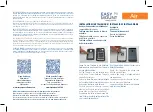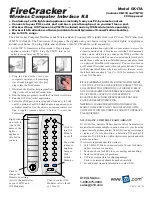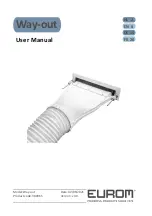
10
Before the first ride
The FLYER should be ready for use and adjust-
ed to your body. Before the first ride, please
check that the following components are se-
cured and correctly positioned (chapter 7 – Ad-
justing the bicycle to the rider):
• Seat
• Please allow your specialist retailer to posi-
tion and secure your handlebars and stem.
• All brakes
• The wheels into the frame and fork
• All quick releases & screwed connections
(see chapter 33.3 on torques)
Lift your bike up slightly and allow it to drop on
its wheels. If there is any play or noises such
as clattering, do not begin your ride. Look for a
FLYER specialist retailer who can identify and
remedy the source of the problem.
If you attempt to push your FLYER with the
rear brake applied, the rear wheel should lock,
while if you attempt to push your FLYER with
the front brake applied, the rear wheel should
lift into the air. Take a test ride in a safe place
and carefully test the brakes. During the tech-
nical evolution of the past few years, bicycle
brakes in particular have become very power-
ful, which means that the braking performance
and application takes some getting used to.
The bike should not rattle or exhibit any play
while steering and applying the front brake.
Check tyres and wheels for:
• Damage
• Cracks
• Deformation
• External particles embedded (e.g. sharp
stones, glass)
• Concentricity
• Bent or broken spokes
Do not ride on any account if you have discov-
ered a fault, instead please allow a specialist to
remedy the issue first!
Check the tyre pressure. The manufacturer
guidelines which may not be exceeded or un-
dercut are printed on the side of the tyres. If
you do not find any printed information there,
please adhere to the following rules of thumb:
• Depending on the type of use, the correct
tyre pressure varies between 4 and 5 bar
• The narrower the tyres, the more pressure
they require in order to avoid the risk of a
flat tyre
• If you forcefully press your thumbs into a
pumped up tyre, there should not be much
“give”.
5. Before the first ride
Modern brakes have a sub-
stantially higher braking per-
formance than conventional
brakes. Carefully practice using your
brakes.
Also remember that the effective-
ness of rim brakes can be substantially
reduced in wet conditions or on slippery
surfaces. Expect a longer braking dis-
tance if you are riding in the wet!
If your pedals are produced with
a rubber or plastic coating, first
carefully familiarise yourself
with the grip of the pedals. These types
of pedals are especially slippy in wet
conditions.
Summary of Contents for Flyer
Page 1: ...Operating manual ...
Page 2: ......
Page 3: ......
Page 4: ...Info Lo Power Hi Mode ...
Page 92: ......
Page 93: ......
Page 94: ...Supplied by ...















































